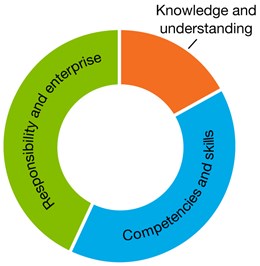Explore content
The Australian Curriculum in this year level supports the development of all dimensions of consumer and financial literacy as shown in the diagram below.

Approximate proportion of dimensions addressed in Year 6
Typically, at this level, students learn about decimals and percentages and how these can be applied to purchasing decisions such as discounts. They explore the concept of opportunity cost and explain why decisions about the selection of resources involve trade-offs. Students investigate the role of government and laws for individual and national wellbeing, how citizens participate and how taxes serve the community. They investigate the different ways that businesses deliver goods and services and the various payment options that exist for consumers.
Students have developed and are able to apply knowledge, understandings and skills to a range of consumer and financial contexts. They explore the impact that the decisions of individuals may have on themselves and their families, the broader community and the environment. They comprehend more complex informative and persuasive texts relating to consumer and financial matters, and analyse these texts to identify purpose, viewpoints and reliability, including identifying and explaining the key features used to influence consumer decision-making. They select and apply mental and written strategies and appropriate digital technologies to solve problems, and create simple financial plans, budgets and cost predictions. They analyse, manage, manipulate and present consumer and financial data and information in a range of formats. They apply enterprising behaviours to real-life contexts such as creating goals, generating ideas, negotiating and developing plans to complete tasks and working collaboratively. When sharing ideas and communicating in online environments, students apply social and ethical protocols that acknowledge factors such as social differences and privacy of personal information. They use criteria and assess the advantages and disadvantages of alternative choices to make responsible financial and consumer decisions that consider values, ethical perspectives, risk, safety and wellbeing, sustainability and personal goals.
Moneysmart for teachers provides a number of interdisciplinary units and interactive activities that support the teaching and learning of consumer and financial literacy in this year level. Access a list of relevant resources that link to the Australian Curriculum using the right-hand menu.
Year 6 The fun begins: Plan, budget, profit!
Year 6 It’s raining cats and dogs... and chickens?
Digital activity – Helping out
Digital activity – Calls, messaging and browsing
Digital activity – Choosing a mobile plan
Digital activity - Entertainment
Digital activity – Fun day out
Digital activity – MilbaDjunga – Smart Money – Primary Unit
Digital activity – Mobile credit

